
Dr. Russell F. Mizell
North Florida Research and Education Center
University of Florida
Route 4, Box 4092
Monticello, FL 32344
The Problem: Insects in the horse fly family Tabanidae suck blood and are very important nuisance pests of man and livestock as well as wildlife. As blood suckers their bites can be very painful and when large numbers are present they can be extremely annoying. Some people develop allergic reactions to the bites which often swell and turn into nasty red sores. There are somewhere around 4300 species of Tabanids in the world and over 300 in North America. At least two major groups of Tabanids are commonly recognized by most people: the horse flies and the deer flies - sometimes called "yellow" or "pine" flies. Different deer fly species occur at different times during the year and often are found in high populations in local areas. When this is a back yard or favorite fishing spot, deer flies can become a real problem for people and pets.

What The Trap Does: When used properly the deer fly traps discussed here are highly attractive to deer flies or pine flies in the genus Chrysops, which are most of the species that readily attack people. Most deer flies attack people and pets around the head, neck and shoulders. Yellow flies usually attack the legs. The trap does not catch horse flies or yellow flies very often. The trap is effective because the flies respond to the trap's motion, color and size. The trap is covered with a special sticky material which catches the flies when they land.

How Do You Make The Trap: What trap you make and the materials you use depends on trap placement and what you wish to do with the trap. Through careful experimentation we have determined that a 6-inch plastic nursery pot painted a bright blue is the optimum size and color. Placed on a rod (as in the figure below) upside down, it will rotate and shake which enhances the trap's attraction to deer flies.
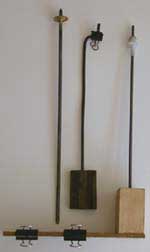
Mounted on a vehicle, tractor or front or back (front is best) of a lawnmower or four-wheeler, the 6-inch blue pot will catch large numbers of deer flies. Driving around an area several times slowly (<7mi/hr, we call this "Trolling") will reduce the deer fly populations considerably until new flies arrive.
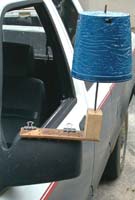
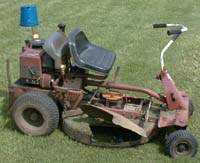
However, if you want to reduce the number of deer flies landing on your body, a smaller trap on your head is more practical (if you don't mind the embarrassment). Except when they are on people, traps only work well if they are in motion.

The motion must have angular displacement, i.e. movement through space. Deer flies are mostly ambush predators, they sit and wait for their prey to come to them. Thus, the trap will not work if it sits in one place even if it is rotating or shaking. Traps must be moved through space. Deer flies usually fly at heights lower than 10 feet and usually attack the highest available area on the human body first. Walking with a trap mounted on a pole and shaken overhead can be effective.
Black and red colored traps will also catch deer flies but in lesser numbers.
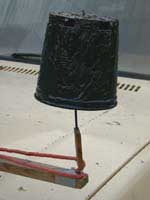
Clean up: Traps must be covered with a sticky material, Tanglefoot, (available at many garden centers) to catch and remove the flies. Tanglefoot can be a problem to use but can be readily removed with hand cleaners that contain citrus extracts like d-limonene. GoJo Natural Orange Pumice Hand Cleaner works very well.

During our experiments we caught thousands of deer flies by trolling traps slowly on vehicles in different habitats'.
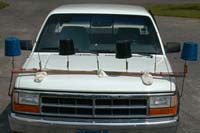
Some other important facts about deer fly biology and behavior. Deer flies are active for the most part during daylight hours but a few feed after dark. Some are more active in the morning or evening. Adult deer flies spend a large portion of their time resting on vegetation. Different species are found in different habitats. Adults of some species are found exclusively along hedge rows and edges of woods or in the forests. Other species prefer more open areas with sparse vegetation such as old fields. Adult deer flies are present from early Spring to late Fall but each species has its own period. Adult deer flies are swift, strong fliers and may fly more than a mile from their breeding areas. Most deer flies require a blood meal to develop eggs. However, they also feed on pollen, nectar and perhaps insect excreta, honeydew. Eggs of most deer flies are placed on vegetation in moist areas. Most of the immatures or larvae are found in water or wetlands and are predacious on other organisms or eat vegetable matter. Tabanids as a group can mechanically transmit (on their mouthparts) disease organisms such as bacteria, viruses, trypanosomes and rickettsia. They also have their own natural enemies such as dragonflies, wasp, spiders and birds.
For additional information about deer, yellow and horse flies (distribution, life cycle, description, damage, biological control, management and selected references) see the University of Florida Featured Creatures publication on these flies.